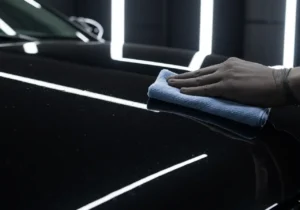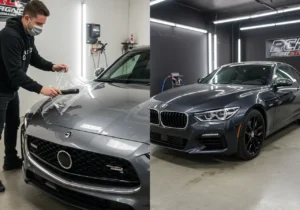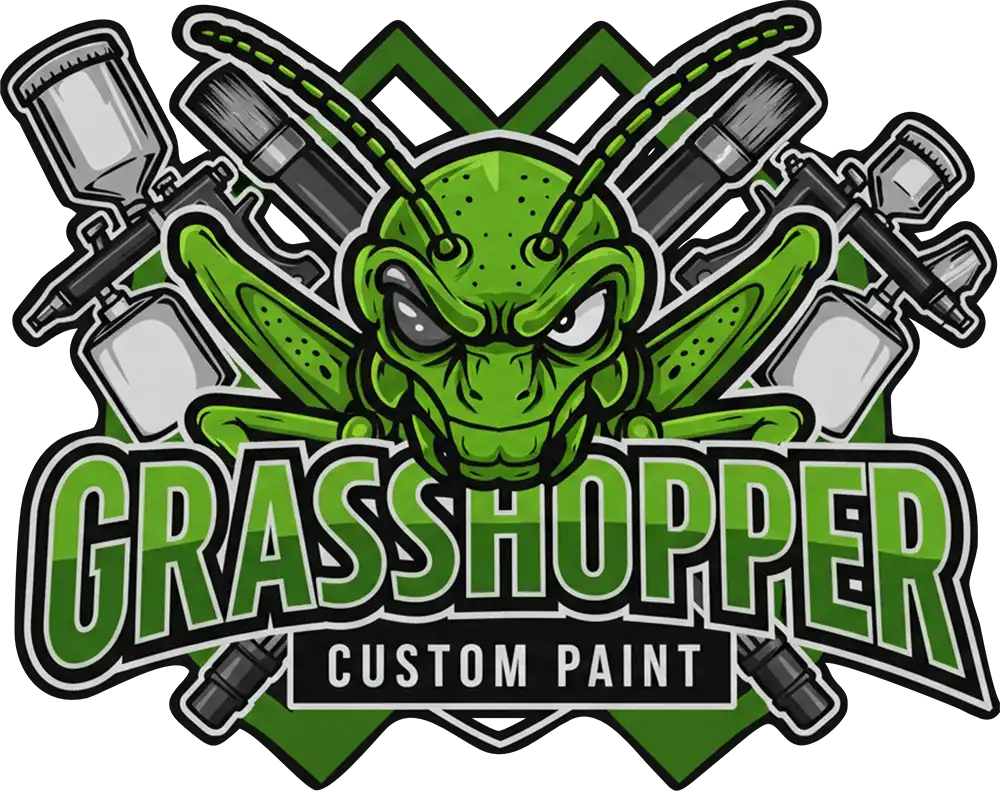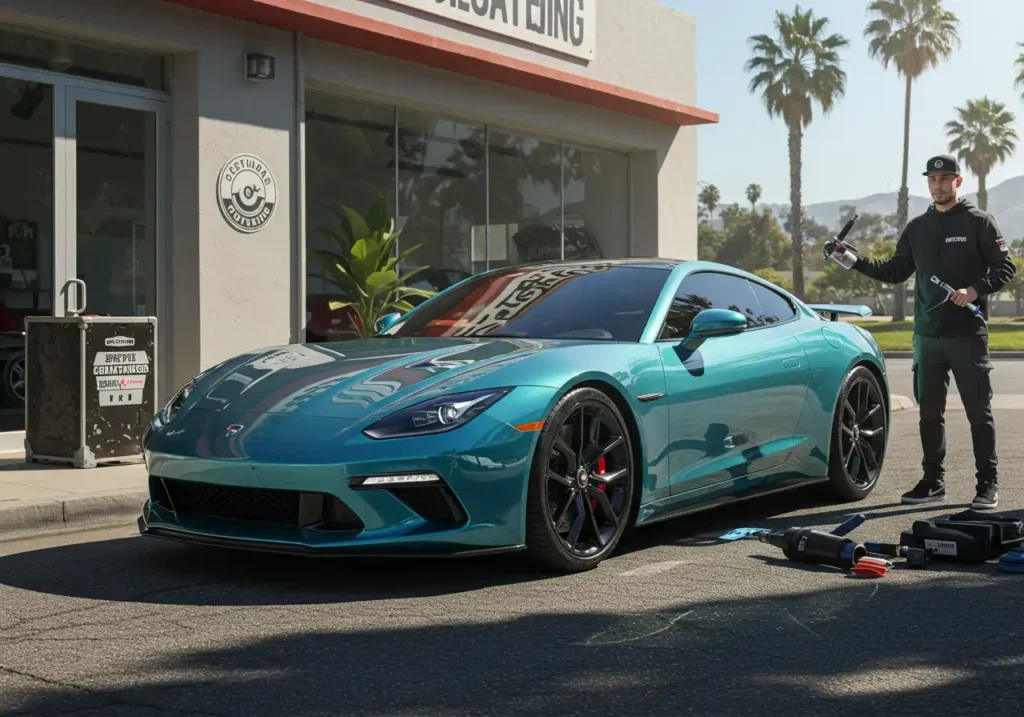If you’ve invested in a custom paint job, protecting it should be your next priority. In 2025, the two most popular protection options are Paint Protection Film (PPF) and ceramic coating. Both extend the life of your paint and preserve that deep, glossy finish, but they work in different ways. This guide explores the pros, cons, and best uses of each, so you can make an informed choice for your ride.
What Is Paint Protection Film (PPF)?
 PPF is a clear, flexible urethane film that covers your paint to shield it from rock chips, scratches, bug splatter, and road debris. Modern PPFs are self-healing—minor scratches fade when heat or sunlight warms the surface. High-quality films can last from 5 to 10 years with proper maintenance.
PPF is a clear, flexible urethane film that covers your paint to shield it from rock chips, scratches, bug splatter, and road debris. Modern PPFs are self-healing—minor scratches fade when heat or sunlight warms the surface. High-quality films can last from 5 to 10 years with proper maintenance.
PPF works like armor for high-impact zones such as front bumpers, hoods, mirrors, and rocker panels. Many enthusiasts now protect entire vehicles, especially when showcasing complex metallic or chameleon finishes.
What Is Ceramic Coating?
Ceramic coating is a liquid polymer applied to the paint, which chemically bonds with the clear coat. Once cured, it forms a hard, hydrophobic layer that repels water, dirt, and contaminants. The result is ultra-high gloss and easier cleaning. Ceramic coatings are not impact-resistant like PPF, but they defend against UV rays, chemical stains, and oxidation.
Depending on the formula and care routine, modern coatings last two to five years or even longer when professionally maintained.
PPF vs. Ceramic Coating: Head-to-Head Comparison (2025)
| Feature | Paint Protection Film (PPF) | Ceramic Coating |
|---|---|---|
| Protection Focus | Physical impact, chips, scratches | UV, chemical stains, ease of cleaning |
| Typical Lifespan | 5–10 years | 2–5 years |
| Finish Appearance | Invisible, factory-look finish | Deep gloss and slick surface |
| Maintenance | Gentle washing, no edge pressure | Routine washing and top-ups |
| Cost Range* | $$$ (full-body protection) | $$ (less labor-intensive) |
*Exact cost depends on vehicle size, complexity, and brand of material used.
Can You Combine Both for Maximum Protection?
Absolutely. Many owners now install PPF on high-impact areas and apply ceramic coating over the entire vehicle—including on top of the film. The coating adds extra gloss and hydrophobic behavior, while the PPF handles impacts. This hybrid setup merges the strengths of both products and helps custom paint keep its depth and brilliance for years.
When to Apply Protection After a Fresh Paint Job
After a custom repaint, patience is key. Paint must fully cure and out-gas before adding PPF or ceramic coating. Most professional painters recommend waiting two to four weeks, depending on temperature and the paint system used. Rushing the process can trap solvents and cause film adhesion issues. Always confirm cure status with your painter before scheduling protection services.
Maintenance and Care Tips
- Washing: Use a pH-neutral car shampoo and the two-bucket method.
- Drying: Use plush microfiber towels—avoid chamois or rough cloths.
- For PPF: Keep pressure-washer nozzles at least 3 feet from edges.
- For Ceramic: Avoid abrasive cleaners; use a silica spray for refresh.
- For Both: Regularly inspect edges and surfaces for contaminants.
These habits preserve both your protection layers and the integrity of the custom finish beneath them.
Real-World Scenarios
Daily Drivers: If your car sees heavy traffic or long commutes, invest in PPF on the front clip, mirrors, and rocker panels. Top it with ceramic for effortless cleaning.
Weekend Show Cars: You might prefer ceramic coating only—ideal for high gloss and easier polishing before events.
Track or Adventure Vehicles: Go for full-body PPF plus ceramic overcoat to withstand debris and heat cycles.
Environmental Considerations
2025 has brought new eco-formulations for both PPF and ceramic coatings. Modern PPF adhesives are non-yellowing and solvent-free, while coating brands are developing low-VOC ceramics to reduce environmental impact. Choosing these next-generation materials keeps your customization sustainable and compliant with newer automotive regulations.
How We Protect Custom Paint at Grasshopper Custom Paint
 Every finish tells a story—from pearlescent candy coats to stealth satin wraps. At Grasshopper Custom Paint, we tailor protection to your lifestyle and paint system. Our specialists evaluate driving conditions, color type, and desired sheen before recommending a plan that fits your goals.
Every finish tells a story—from pearlescent candy coats to stealth satin wraps. At Grasshopper Custom Paint, we tailor protection to your lifestyle and paint system. Our specialists evaluate driving conditions, color type, and desired sheen before recommending a plan that fits your goals.
Typical protection plans include:
- Front-End Defense: Full-front PPF coverage with ceramic top-coat.
- Show-Finish Package: Multi-layer ceramic system for ultra-deep gloss.
- Full-Body Hybrid: Entire car wrapped in self-healing PPF plus top-tier ceramic coating.
Ready to safeguard your custom paint? Contact our team to schedule a free consultation and see the best protection strategy for your ride.
Related Reads
- The Art of Custom Auto Paint: Techniques and Trends
- Top Custom Paint Trends for Cars and Motorcycles 2025
- Chameleon Color-Shifting Paints: Bring Your Ride to Life
FAQ
Is ceramic coating enough for highway driving?
Ceramic coating protects against UV and chemicals but not rock chips. Add PPF on front-facing areas if you do frequent highway driving.
Can I apply ceramic coating on top of PPF?
Yes. Many professionals coat over PPF to enhance gloss and hydrophobic behavior while maintaining impact protection.
How long do these protections last?
PPF lasts five to ten years, while ceramic coatings generally last two to five years. Longevity depends on product quality and maintenance habits.
How do I maintain the shine?
Use gentle car shampoos, avoid harsh chemicals, and refresh ceramic coatings annually with approved toppers.

